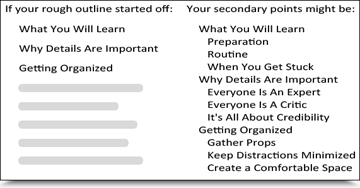Nothing is for sale here. Freewill tips keep the site running. Want to help? → Tip via Paypal
Content Writing Process | An 8-Step Guide
Sometimes we can just wing it when it comes to writing. That usually works for short pieces, but a longer, more complex writing task needs a little structure or it can be hard just to get started. Even if you do get started, it's hard avoid backtracking, moving things around, and editing what you've already written to fit in things you forgot. It's disruptive to the creative process of writing.Epic content is more difficult to create if you just wing it. You wouldn't drive across the country without a roadmap (OK, GPS these days, but roll with the analogy), you'd surely get lost multiple times. By the same token, long-form content writing without a "roadmap" will find you lost multiple times, too. Use the following formula to polish your creation so that it is as good as it can be when you hit publish.
- 1. Brainstorm
- Before you can publish content online you need a topic! Shocking, isn't it? If you have your topic skip to the next item. If not, refer to the brainstorming article on how to come up with content ideas. Remember the more innovative, unique, challenging or valuable your topic is, the better it will likely perform.
- 2. Rough Outline
-
Draw up a rough outline. It can and should be very rough. There's no need to worry about grammar, punctuation, or any of that "writer" stuff. Just get your primary ideas down. List only your major points. You'll fill in the details later.
If you don't usually use outlines, here's why you might want to try it…
Content with 2,000 words or more is going to have a lot of individual parts. An outline helps ensure you hit all the main points you want to make and helps bridge the pieces together in a logical order. It becomes your road map to your end destination. All else being equal, long-form content has been proven in multiple studies to generate more backlinks and rank better in search results. As I mentioned earlier, you probably won't need to do this for short articles. For content you write with viral potential in mind, it's a good idea to develop a repeatable process. - 3. Fill the Rough Outline with Secondary Points
-
 Now that you have a rough outline ready with your major points, list the secondary details you want to cover under each major point. The idea is you're essentially making a rough outline for each section of your original rough outline. See the example outline image.
Now that you have a rough outline ready with your major points, list the secondary details you want to cover under each major point. The idea is you're essentially making a rough outline for each section of your original rough outline. See the example outline image.
In other words, jot down some ideas, data, problems, solutions, subsections and information that will flesh out each section of your outline—when you actually start the writing process. This still isn't the time to worry about grammar or structure. This will give you direction when you create your first draft and help ensure you don't miss any needed points.
If needed you can repeat the process and list sub-points to your secondary level outline. Drill down with this process as deeply as you need to go. The more complex the subject matter the deeper you may want to go with the process. Just be sure drilling deeper is helping rather than a subconscious exercise to avoid getting started with the actual writing. Many who say they want to write never make a serious attempt for various reasons. - 4. First Draft
-
Now that your rough outline is finished and you've added your secondary details, it's time to write the first draft. You needn't worry about grammar and punctuation here either. You'll clean things up later on.
The reason for not worrying about grammar and punctuation yet, is because that's part of the editing process, not the creative process. Grammar involves judgment, and creativity doesn't like to be judged while it's creating. Judging dampens the creativity.
So, just write. Get all your ideas and thoughts down, even if they seem absurd. Weed them out later. There may be a reason something popped into your head even if it isn't readily apparent to you at the moment.
Let me tell you a little secret...
Sometimes when I really get into a good writing flow I just run with it as far as it takes me. I don't read it as I write, and often don't read what I've just written until the next day. When I do read it I'm sometimes amazed at what I see. I won't even remember having written some of it. It's like the writing fairy came around after I stopped writing and added all the good stuff. That won't happen if you let the inner critic constantly judge what you write as you write.
When your inner critic starts picking at you, tell it to run up an alley and holler fish. It has to be trained not to interfere. - 5. Format
-
Add headings, bullet points, lists, bold and underlined text, italics, images, videos and all that formatting. Break up your text, add white space and make it easy to read.
You could move this step down the list, but I find doing this before the first edit sparks new ideas that can be included. You'll discover what works best for you as you create your epic content, so if editing the rough draft before formatting the content works better for you, that's the way you should do it. - 6. Edit and Rewrite Your First Draft
-
Only edit the content after walking away from your project for at least 24 hours, and 48 or 72 hours is usually better. You'll be amazed at the errors you will find and new ideas you come up with.
This is where you clarify your ideas, yes, but also where you add pizzazz to your writing. Adding pizzazz may be as simple as adding superlatives to your words here and there to make it more exciting or as creative as adding analogies and clever phraseology to your content.
Tip: Make sure your "clever wording" is still easily understood. You don't want your readers wondering what you meant to say. - 7. Print It Out, Read It Out Loud, and Ask for Help
-
The company who published my book suggested I print out each chapter as I finished it and then go over the printed copy looking for errors and places for inclusions. He said I'd see things on paper that I didn't see on my computer screen. He was right. I found a lot of things to edit or add that way.
Another tactic is to read your copy outloud. It doesn't matter if you do this from the printed page or from your computer screen. You'll find plenty of glitches doing this, too. This is a professional copywriter's trick that works wonders to find problems with the flow of words that are not always readily apparent when you read it silently.
Another proven tactic is to recruit a friend, family member, or trusted employee or business associate to read it and give you feedback. They may find problems you don't see, or offer a good idea or three that you can use.
Finally, if you want to go one step farther, have someone else read it out loud to you. You may find more things you couldn't find while reading it out loud to yourself. It's all about changing your input methods to see things differently, and it may surprise you how much you find with each fresh angle you look at it from. - 8. Final Edit and Rewrite, Then Publish
- Make a final edit. Take out every word or sentence that doesn't belong. Perform your final rewrite, add polish, and then publish that great content!
 I often let a content piece "sit and simmer" for a few days before I publish it. Then I'll go back over it one last time. That fresh look often generates another good idea or two to add to the mix. Just be careful not to work it beyond the point of diminishing returns. It will never be perfect, and it doesn't have to be, to be epic.
I often let a content piece "sit and simmer" for a few days before I publish it. Then I'll go back over it one last time. That fresh look often generates another good idea or two to add to the mix. Just be careful not to work it beyond the point of diminishing returns. It will never be perfect, and it doesn't have to be, to be epic.
Previous Article in this Series: Brainstorm Epic Content Ideas
Next Article in this Series: Promoting Your Content





